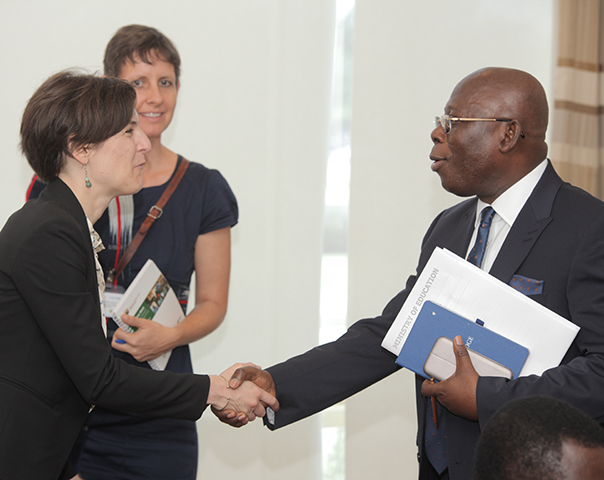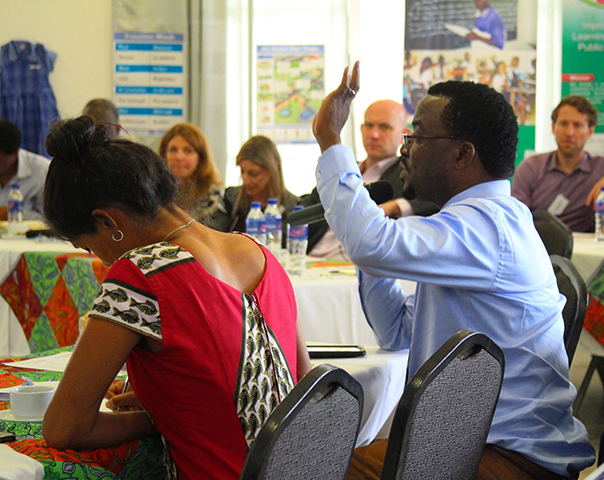The Challenge
Small business training programs are widely used by governments, aid agencies, and NGOs to improve entrepreneurial outcomes in low- and middle-income countries. Still, their long-term effectiveness remains largely unknown since most evaluations only track businesses for one to two years.1 In Togo, where many people run small, unregistered businesses, owners struggle with limited access to money, markets, and business skills.2 These small business owners primarily use their own money to run their businesses, facing significant challenges to make investments, and lack basic business structures, making growth difficult.3 Standard business training typically teaches accounting and marketing, but it is unclear whether these approaches lead to lasting improvements, especially when the mindset and confidence of business owners might be equally important barriers to success.4
The Intervention
Funded by IPA and the World Bank, researchers conducted a randomized evaluation of a personal initiative training program for small business owners in Lomé, Togo. The study involved 1,500 established small businesses that were randomly assigned to one of the following groups:
- Personal initiative training group: Received psychology-based training that taught entrepreneurs to be proactive, identify opportunities, overcome obstacles, and develop financial bootstrapping skills.
- Traditional business training group: Received standard training on business practices like accounting, financial management, and marketing.
- Comparison group: Received no training.
Both training programs consisted of 36 hours of classroom instruction over four weeks, followed by monthly mentoring visits for four months to answer follow-up questions and anything related to implementation.
Researchers conducted four follow-up surveys up to 2.5 years after the trainings took place, and completed a final long-term survey seven years after the intervention
Results
Short-Term Outcomes
The short-term results were measured up to 2.5 years after the implementation
Most businesses remained active, with 93 percent still operating by the study's end. The personal initiative training group showed notable improvements. Their monthly sales increased by 114,735 CFA francs (USD 241), which was 17 percent higher than the comparison group. Monthly profits rose by 28,709 CFA francs (USD 60), a 30 percent increase.
Profit gains were consistent across different types of businesses. Companies that received personal initiative training saw profit increases at every level of business performance. These improvements were similar for businesses owned by both women and men.
Beyond financial performance, the personal initiative training produced additional positive outcomes. Businesses that received this training were more likely to introduce new products and expand their product lines. They also showed increased confidence in their ability to borrow money and actually borrowed more funds. Compared to traditional training, the personal initiative approach led to more significant improvements in business innovation and financial access.
Long-Term Outcomes
The long-term results were measured up to 7 years after the implementation
The long-term impact of personal initiative training on entrepreneurial success was significant. Seven years later, entrepreneurs who received personal initiative training earned USD 91 more in monthly profits than those who received no training, a 52 percent increase. Business survival was high across all groups, with about 90 percent still operating after seven years.
Men and women had different long-term results. For men, the effects of personal initiative training grew over time. Seven years after training, men earned USD 148 more in monthly profits, a 77 percent increase. For women, the long-term effects were much smaller. While women showed similar two-year gains as men, after seven years, the estimated impact was only about one-quarter as large, and although positive, it was not statistically different from that of women who did not receive the training.
One key mechanism behind the gender gap in outcomes was the increase in capital and confidence in their ability to run their business. Men who received training increased their capital stock—business equipment and machinery—by 81 percent and gained greater entrepreneurial self-efficacy—confidence in running their businesses. This may have created a positive cycle: increased confidence may have led to better business results, which in turn reinforced their confidence. In contrast, women invested less than one-third as much as men and did not experience the same boost in their confidence to run their own business. Men were also better able to borrow when needed. Still, both men and women improved their business practices.
Another key mechanism was financial decision-making power. Women with full control over their business finances at baseline performed somewhat better, suggesting that the ability to make independent financial decisions is important for women’s business success.
Policy Implications
Incorporating psychological elements into business training could improve its effectiveness, but addressing gender-specific barriers is crucial to ensure that both men and women achieve sustained business growth. The gender differences in long-term impacts suggest that women, in particular, may benefit from additional support, such as better access to capital or sectoral opportunities. Future research could explore whether combining personal initiative training with targeted support could lead to more balanced outcomes.
Sources
1 David McKenzie, Christopher Woodruff, Kjetil Bjorvatn, Miriam Bruhn, Jing Cai, Juanita Gonzalez-Uribe, Simon Quinn, Tetsushi Sonobe, and Martin Valdivia, "Training Entrepreneurs," VoxDevLit 1, no. 3 (September 2023).
2 World Bank, "Enterprise Surveys: Togo 2023 Country Profile," (Washington, DC: World Bank, 2023).
3 Boundjou Sonhaye and Kounetsron Yao Messah, “Analyse Des Besoins de Financement Des Microentreprises Au Togo : Rôle Du Microcrédit.” 2022. Ijafame.org. 2022. https://ijafame.org/index.php/ijafame/article/view/500/500.
4 Michael Frese and Doris Fay, "Personal Initiative: An Active Performance Concept for Work in the 21st Century," Research in Organizational Behavior 23 (2001): 133-187.











